B2B SaaS SEO: Strategies to Get More Leads in 2024
- by Taylor Scher
- Last Updated:
Table of Contents
Key Insights
This article will walk you through the different ways you can do SEO for your B2B SaaS. The goal is to help you better understand what you should be focusing on and what the overall goal of SEO is, especially for SaaS companies.
We all know SEO can be a tough channel to execute.
From the time it takes to work to the lack of a guarantee for it to work.
For B2B SaaS companies with long sales cycles, it can feel like a waste of money and resources for little return.
While I won’t argue that SEO is a hard channel to execute, I’m hoping to show a few ways you can shift your focus and see better results from your SEO.
Both tactically and strategically.
Let’s jump in.
Everything You Need to Do SaaS SEO the Right Way
#1. Have an Idea of your Ideal Target Audience and Persona
Before starting anything SEO-related, you have to start with audience research.
You need to know who your target market is and which decision-makers you’ll ultimately be targeting.
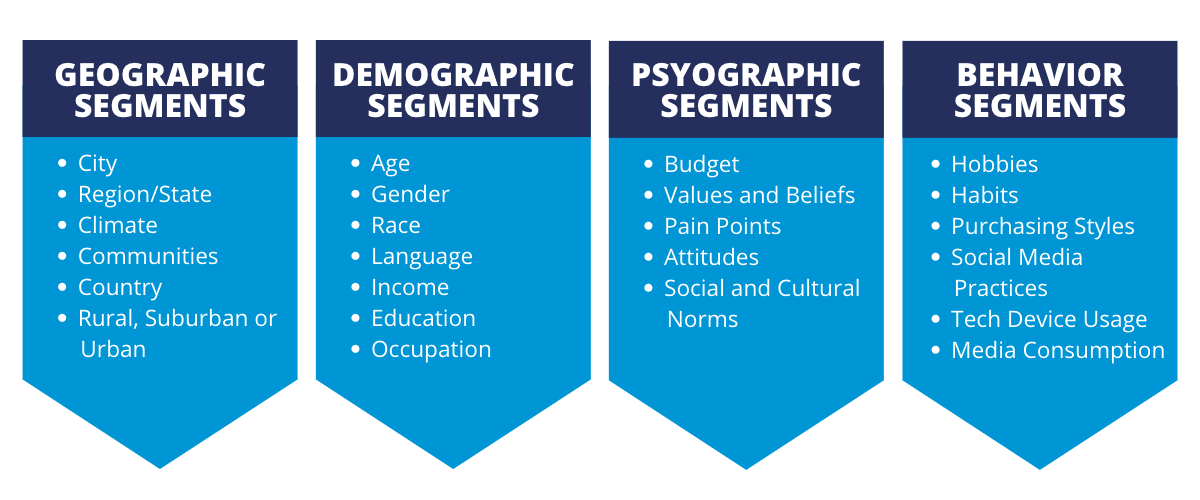

Source: WaypointMC
For content marketing and SEO to work, you need to fully understand your audience.
You first want to identify the person who will ultimately make or influence a purchasing decision.
For example, if it’s employee retention software, your decision-makers could be middle management or HR teams who are currently dealing with issues retaining employees.
Now, there are a few different categories for these decision-makers.
Some are:
- Problem-Aware
- Problem-Solution Aware
- Product Aware
So yes, step 1 is to identify your target audience, and step 2 is to target them at each point in their buyer’s journey.
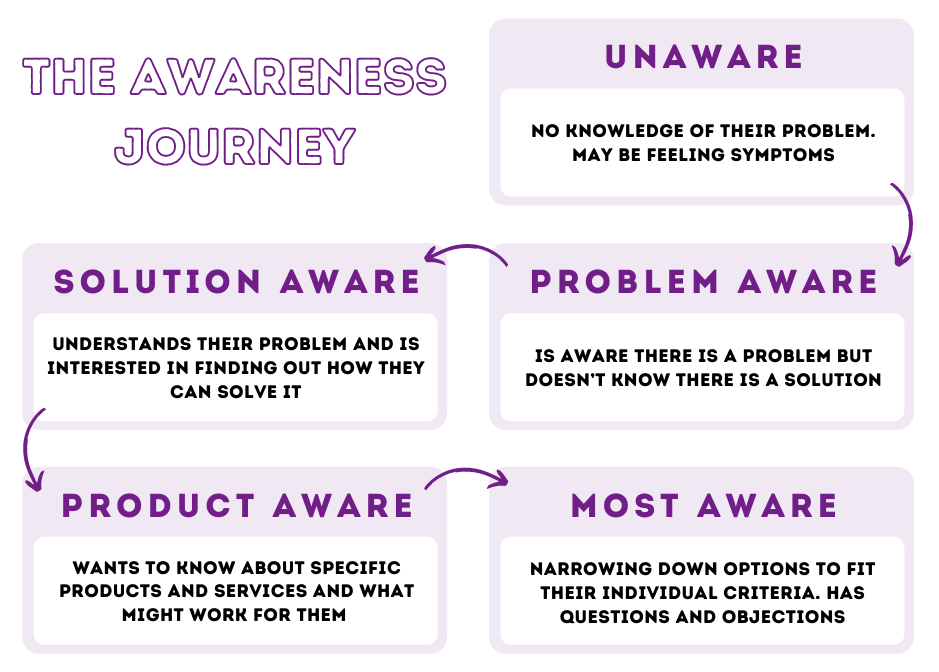

Source: Automation Ninja
When your audience is problem-aware, they know their problem exists, yet they’re unaware of potential solutions.
Taking this a step further, when your audience is problem-solution aware, they know a solution exists for their problem, but they’re not entirely sure what that exact solution is.
Lastly, we have product-aware (and most-aware), where your audience knows the exact solution they want, but now it’s a matter of picking the best one.
#2. Understand What Separates You From The Competition
Yes, we will get to the actual SEO, but I want to emphasize how important strategy is here.
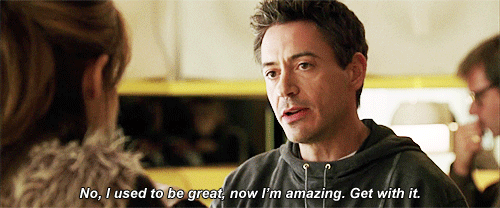

And, of course, you need to have a strong value proposition for your marketing to work.
You don’t want to be like every other software company out there.
It would be best if you had an identifiable differentiator from them.
Pro tip: You can do this by focusing on:
- Your brand messaging and voice
- Your value proposition and mission statement
- How your product differs from the competition
- Why a person should choose your product over the competition
#3. Understand the Industry and Niche/Vertical You Operate In
Pinpointing your target audience and buyer persona will take some heavy work.
For example, B2B SaaS brands operating in a broader niche have multiple decision-makers to target, whereas a SaaS in a smaller niche will likely have only one decision-maker to target.


Source: Revlitix
This can be a pro or a con, but in most cases, the more you niche down, the less decision makers you can reach with SEO.
Not only will you have less competition, but standing out organically will be much easier, too.
Your decision-makers will also relate more to your product if it was made specifically for them vs a broader software targeting everyone.
#4. Reverse Engineer Your Competitor’s SEO Strategy
You can use tools like Ahrefs or SEMrush to mine your competitor’s SEO strategies.
While you don’t want to copy their strategy word for word (or keyword for keyword), you want to find the topics that may be driving results for them.
You can use Ahrefs or SEMrush to look at BoFu topics coming from your competitors.
These will come from modifiers like “vs,” “alternative,” and “best.”
Plug in your brand name to see if they are creating articles against you, too.
You can also use Ahrefs to look at the keywords they’re bidding on for PPC.
Chances are, if they’re actively spending money on that keyword, it’s a keyword worth going after
#5. Focus on E-E-A-T for your content. Especially for Brands in a YMYL industry
Some SaaS brands might be operating in a Your-Money-Your-Life industry (YMYL).
This means Google will measure your content with a different lens since it can potentially impact the readers:
- Health
- Financial stability
- Safety
- Well-being.


Source: Digital Guider
The most common SaaS verticals affected by YMYL are:
- Fintech
- Medtech
To avoid issues with YMYL, you should also prioritize E-E-A-T.
E-E-A-T stands for:
- Experience
- Expertise
- Authoritativeness
- Trustworthiness
Simply put, E-E-A-T is a set of criteria used by Google’s search quality raters to evaluate the quality and credibility of website content.
While Google does not use scores for E-E-A-T, they are still a solid guideline for creating helpful content.
You can read this PDF to get a better understanding of Google’s Search Quality Rate Guidelines.
#6. Find Quick Wins That Have Conversion Intent. Preferably Software/Product Keywords
Don’t neglect your quick wins, either.
Especially when they have conversion intent.
Usually, these will boil down to your product keywords, such as “software,” “tool,” or “app.”
For example, if you have a keyword like “data appending software” ranking in position 15, we’d want to put a heavier focus on this since someone searching this is looking directly for our services.
They are already solution-aware.
In this case, we won’t need new content (although this does depend on a few factors); we’ll most likely need to update the product page.
So, if the product page is for data appending software, we’ll want to see how we can beef up our page.
We could:
- Start a backlink campaign for that page
- Find information it’s missing by auditing the SERPs for that keyword
- Add internal links to that product page
- Improve the writing used on the product page
- Add new information that hasn’t been covered yet
- Provide a more comprehensive roundup of the product and what it does
#7: Focus on Building Backlinks on Autopilot
We all know backlinks are a pain to build.
Especially for complex niches like life sciences or supply chain analytics.
To make link building easier, you should focus on content designed to earn backlinks.
This could be:
- Statistics articles
- Trend articles
- Thought leadership articles
- Infographics
Additionally, you’re not paying for a backlink either.
These articles are designed to bring backlinks to you rather than you going out for them.
For a Supply Chain Planning SaaS, this could be:
- Supply Chain Trends
- C-Level Thoughts on Industry Trends
- Inventory Optimization Statistics
Articles that will not only bring in links, but relevant ones too.
#8: Don’t Neglect Technical SEO Either
Technical SEO is something you shouldn’t avoid either.
While content and backlinks will be your main focus, technical SEO can make or break your SEO.
If Google can’t index your content, it won’t rank or drive organic traffic.
Don’t avoid page speed, either.
If a user lands on your website page and it barely loads, that will be an immediate red flag.
Not to mention that page speed is also a ranking signal.
Your website is the first impression audiences get from your brand, so everything should look good when they first land on it.
Here’s just a few quick tips on doing technical SEO:
- Audit your entire website. This doesn’t mean using a tool like Ahrefs or SEMrush for site health either; use Google Search Console and Screaming Frog to get a full understanding of your website
- Use Google Search Console’s coverage report to see if pages are being indexed
- Use PageSpeed Insights to see how fast your website loads and fix it if possible. Use a caching plugin, lazy load your images, and use nitropack. All of these will help speed up your website
#9: A List of Pain Points Coming From Your Audience
This will likely come from your audience research, specifically your unaware/problem-aware/solution-aware topics.
With these pain point topics, you can now target your audience’s searches when they’re actively searching for potential solutions.
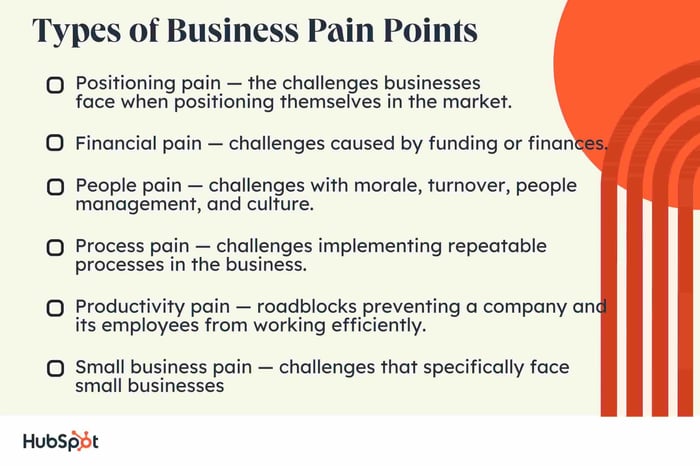

They could already be solution-aware or entirely unaware they have that specific problem.
Either way, you want to take the pain points you found during your audience research stage and create content around them while positioning your product as the main solution.
Now, keep in mind that you don’t want to directly pitch your product and talk about how amazing it is.
You want to walk your readers through the different ways your product can help them with their specific issue.
Show, don’t tell.
Ahrefs is a great example of this if you want inspiration:
#10: Understand The Search Intent of Your Audience
Before optimizing your content, you have to understand what your audience is looking for.
Source: Terakeet
What results does Google want to show for that result?
And what do your readers want to learn?
Search intent is the method of understanding relevance for both search engines and users and understanding what’s necessary to get that content to rank.
If your target keyword is “improving employee retention,” you’ll want to review the SERPs to see what results are showing for that keyword.
You’ll want to avoid creating an informational article if Google only shows service pages for that result.
You could even take this a step further and look at the actual relevancy of the ranking results.
So, if it’s an article on “employee retention,” you’ll want to look into the information the ranking articles cover.
Are they explaining how to improve employee retention?
Are they covering employee retention trends?
Also focus on information gain too.
Likely, the top 3 results got there since they are the most relevant for that keyword.
But is there anything those articles failed to mention?
We want to capture the initial relevancy of our content, but we still want to add uniqueness so our content has new value instead of just being copy-paste content.
A common question to ask yourself is if your content is good enough for Google to rank above the others.
To get around this, you can:
- Interview your C-Level team for insights
- Speak with an SME
- Include quotes from publications in your industry
#11: Match Content Topics Along Your Audience’s Buyer’s Journey/Marketing Funnel
After researching your audience, you’ll want to combine your data and create a content marketing funnel based on their audience’s buyer’s journey.
Source: Qualtrics
Starting with bottom-of-the-funnel content
When you start your SEO, you should always start with topics at the bottom of the funnel and work your way up.
This way, you can capture conversions (revenue) first, then work toward building awareness.
This will likely be “vs/comparison” content.
This allows us to show our audience how we match up against our competition and why we ultimately consider ourselves to be the better solution.
Think about it: what type of user would search this?
Someone comparing two platforms against each other and looking for the best solution.
You can at least control the narrative around your product and help sway the user toward your solution.
And for those who don’t want to mention their competitors, do a search of your brand vs them and see if they have a dedicated article on you.
Now, your competition is controlling the narrative around your product without you being able to defend yourself.
Category Content
To capture more bottom-of-the-funnel searches, you can use “best of” content to attract users comparing different products in their market.
If a user were to perform this search, they would already have shown interest in this type of solution and would now be gauging the best in that category.
So, if you have a page for the “best employee retention software solutions,” users want to know their options and which product is the best.
This is a great opportunity to control the narrative and pitch your software as the “best.”
If you go down this route, make sure you don’t insult the other products.
Make your product the “best” while giving honest reviews about yourself and your competitors.
Examples of Category Content
- Best free SEO tools
- Best employee retention software
- Best Time Tracker App for Freelancers
“Alternative” Content
Similar to “best” content, this type of content applies to people in the solution-aware/most-aware stage.
Users have their options boiled down to a single solution, but they might have some hesitation that causes them to seek other products on the market.
Say your main competitor is Ahrefs.
Ahrefs is known as one of the best tools in the industry, but they are pricey.
Users know they want to use a tool like Ahrefs but can’t due to the cost.
You can capitalize on this by creating an article around “Ahrefs alternatives.”
This is a great opportunity to highlight your product compared to your competition.
You can highlight the pros and cons and show why your product is a solid alternative option.
Examples of Alternative Content
#12: Use Digital PR to Build Site-Wide Authority for SEO and Brand Awareness
Digital PR is still considered one of the most effective link building tactics.
Not only can you scale link acquisition, but you’re also using it to position your brand in front of the right eyes.
Digital PR aims to create an asset that can be used as a story to pitch to journalists in exchange for coverage.
This might sound similar to guest posting, but with Digital PR, you’re going after highly authoritative websites (usually publications) instead.
If you want your story picked up, it has to be newsworthy.
If you were looking to do digital PR for your employee retention software, you could research data on the following:
- Employee Turnover Trends
- Employee Satisfaction Trends
- Tracking Employee Retention
From there, you can use this story to pitch to journalists who write about similar topics.
You could find journalists from publications like entrepreneur.com or SHRM.org.
I recommend using Hunter.io (a popular email marketing software) to find journalist emails.
#13: Create Content That Establishes Your Brand and Employees as Thought Leaders
Another digital marketing strategy that works well for SaaS brands is thought leadership content.
Traditional marketing usually considers SEO and thought leadership content to be two separate tactics.
But there’s no reason for them to be siloed.
Most B2B marketers think SEO sacrifices content quality and puts too much emphasis on writing for search engines instead of readers.
However, there’s nothing that says you can’t create quality SEO content, especially thought leadership content.
A good example of this would be Ahrefs.
Most of their content focuses on general trends within the SEO industry, such as industry insights, trends, and statistics.
Content that positions them as a thought leader while attracting a larger audience through search.
Not to mention, these articles drive a fair amount of backlinks, too.
So, for your B2B SaaS, you could create an industry trend or outlook article that positions your brand as a thought leader while optimizing it for search.
I recommend getting your executives involved since they tend to get more coverage and engagement.
#14: Focus on Building Topical Relevance and Authority With Your Content
Yes, you want your content to drive signups, but it can also be a pillar for your other content.
Specifically when you build topical authority with your content.
If your SaaS is relevant to a specific topic or overall umbrella category (employee retention), you’ll want your content to cover every angle of that topic before moving on to a new one.
You want your content efforts to be hyperfocused on that one category/topic.
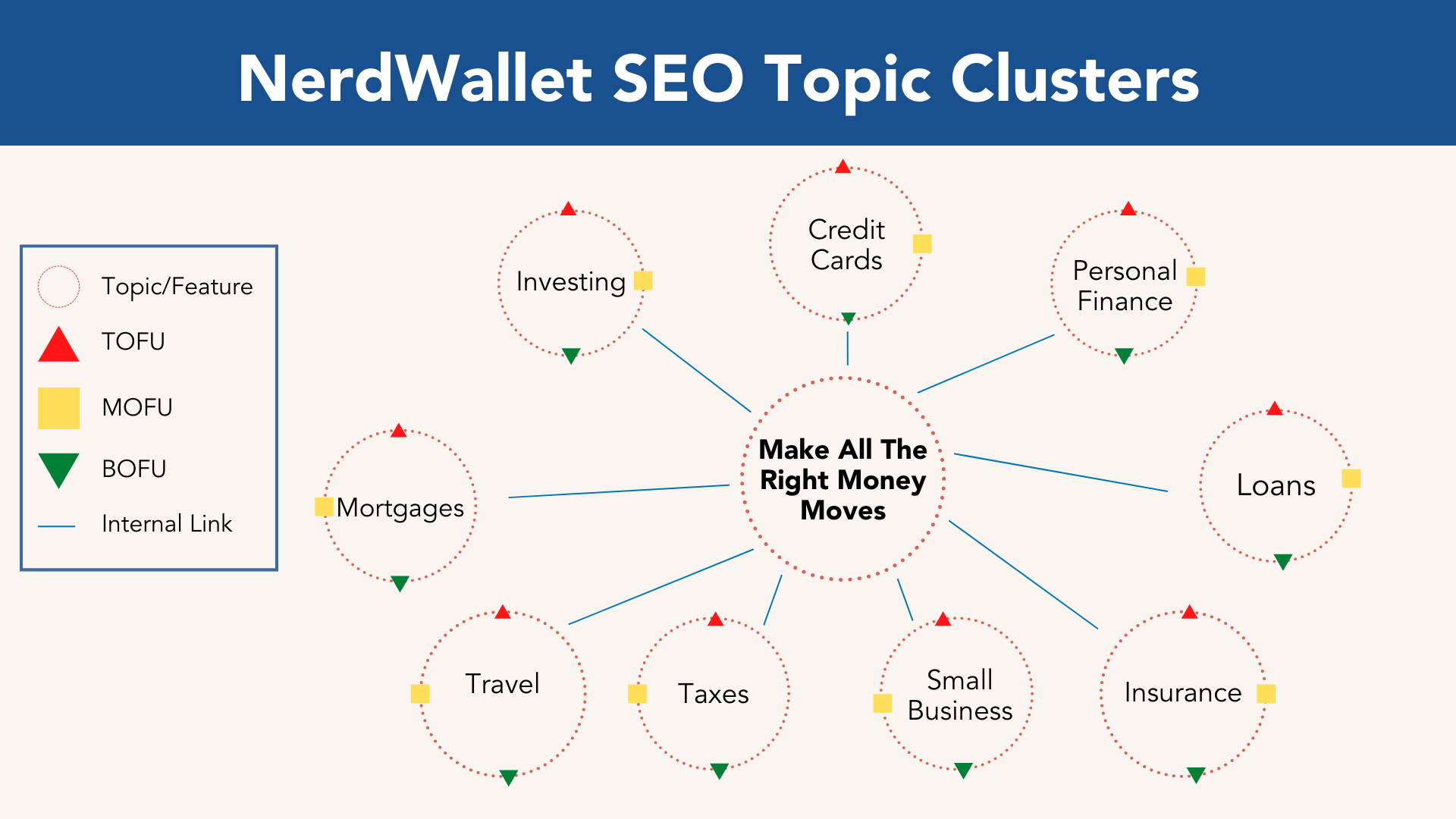
Source: Codarity
Not only for SEO, since it helps search engines better understand who you are and if you’re qualified to speak on a certain topic, but it also works well for your audience.
Instead of taking a shotgun approach to your content, you’ll have more content to nurture your audience throughout their buyers’ journey.
How to Actually Build Topical Authority
Many companies make the mistake of trying to cover multiple topics with their content to capture a wider audience.
However, you should be doing the exact opposite with your content.
You’ll need to cover a topic from end to end to build topical authority.
Covering everything a user would need to know about that full topic.

Source: How the Fxck
You can use a hub-and-spoke approach, with a central guide or pillar page around your topic (the hub) and smaller spoke pages that cover more specific topics.
The hub or pillar piece links to all the spoke pages, which link to each other and back to the hub.
This will create a network of internal links that help search engines connect the dots on your site’s authority.
Not only this, but it does help users better navigate your site too.
You can listen to Ben Goodey’s podcast with George Chasiotis about how they grew Respona to 100,000 monthly clicks by building topical authority.
The main goal is to target your core or commercial intent keywords with a pillar piece and then use your smaller spoke pages to target less competitive keywords.
Using Keyword Glossaries to Build Topical Authority
Another common content marketing tactic for topical authority is to build a keyword glossary for your website.
This keyword glossary acts as a knowledge base for your website and indicates to search engines that you are a trusted source on that particular topic.
I mean, in this case, you quite literally have a dictionary on your website.
Don’t expect as many conversions through a keyword glossary, but it can be a great starting place to build topical authority.
What You Should Focus on to Build Topical Relevance and Coverage With Your Content
Building topical authority involves building pages for every subtopic within your main pillar topic.
Going back to the employee retention software example, your topic cluster for this should revolve around retaining employees and improving overall satisfaction.
Topics like:
- Keeping employees engaged
- Keeping them happy
- Retaining employees
- Why you should retain employees
- Employee retention statistics
Ideally, you want a leading guide covering employee retention and then use subtopic pages to flesh out specific aspects of that topic.
#15: Build Links to Both Your Product Pages and Blog Content, Not Just Your Homepage
When building links, don’t limit yourself to just your homepage.
Aim to diversify your link targets outside your home page, including your product and blog pages.
This will help balance link equity distribution throughout your site, and it’s often easier to pitch links through your blog posts.

Source: Katalst Solutions
Once you’ve built enough high-quality links for your pages, set up internal links that pass your link equity to your product pages and other blog posts.
Get Started on Your SEO Strategy Today
If all of this seems overwhelming, consider hiring a B2B SaaS SEO consultant or agency that can help with operations.
Feel free to schedule a call to discuss how we can grow your pipeline.
